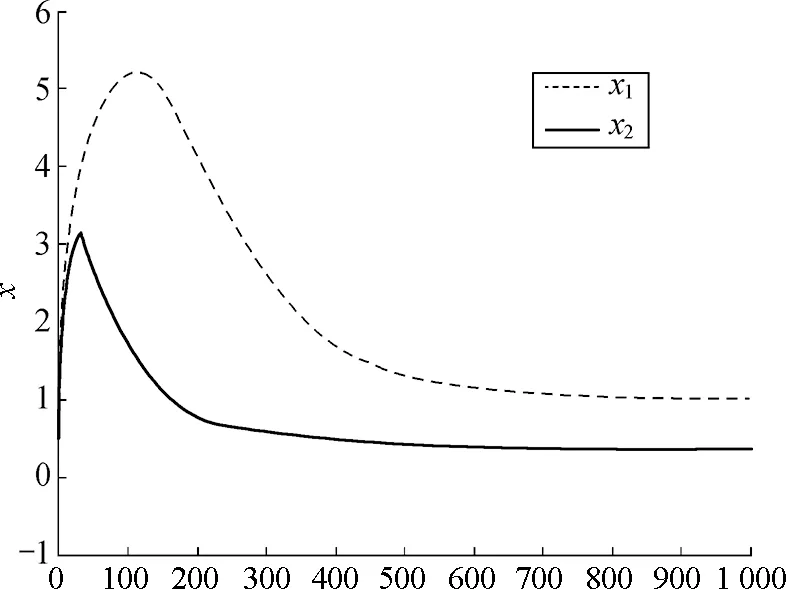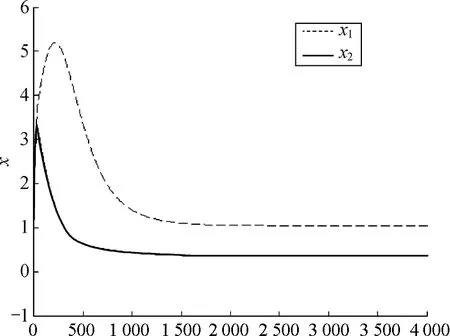Dynamic Analysis of Some Impulsive Fractional-Order Neural Network with Mixed Delay
2015-01-12LIUXianghu刘向虎LIUYanmin刘衍民LIYanfang李艳芳
LIU Xiang-hu (刘向虎), LIU Yan-min (刘衍民), LI Yan-fang (李艳芳)
School of Mathematics and Computer Science, Zunyi Normal College, Zunyi 563002, China
Dynamic Analysis of Some Impulsive Fractional-Order Neural Network with Mixed Delay
LIU Xiang-hu (刘向虎)*, LIU Yan-min (刘衍民), LI Yan-fang (李艳芳)
SchoolofMathematicsandComputerScience,ZunyiNormalCollege,Zunyi563002,China
In this paper, the authors study some impulsive fractional-order neural network with mixed delay. By the fractional integral and the definition of stability, the existence of solutions of the network is proved, and the sufficient conditions for stability of the system are presented. Some examples are given to illustrate the main results.
fractional-orderneuralnetwork;mixeddelay;fixedpointtheorem
Introduction
In this paper, we study the impulsive fractional-order neural network with mixed delay

Itiswellknownthatthedelayedandimpulsiveneuralnetworksexhibitingtherichandcolorfuldynamicalbehaviorsareimportantpartofthedelayedneuralsystems.Thedelayedandimpulsiveneuralnetworkscanexhibitsomecomplicateddynamicsandevenchaoticbehaviors.Duetotheirimportantandpotentialapplicationsinsignalprocessing,imageprocessing,artificialintelligenceaswellasoptimizingproblemsandsoon,thedynamicalissuesofdelayedandimpulsiveneuralnetworkshaveattractedworldwideattention,andmanyinterestingstabilitycriteriafortheequilibriumsandperiodicsolutionsofdelayedorimpulsiveneuralnetworkshavebeenderivedviaLyapunov-typefunctionorfunctionalapproaches.Forexample,Wanget al.[1]investigatedtheglobalasymptoticstabilityoftheequilibriumpointofaclassofmixedrecurrentneuralnetworkswithtimedelayintheleakagebyusingtheLyapunovfunctionalmethod,linearmatrixinequalityapproachandgeneralconvexcombinationtechniquetermunderimpulsiveperturbations.SebdaniandFarjami[2]consideredbifurcationsandchaosinadiscrete-time-delayedHopfieldneuralnetworkwithringstructuresanddifferentinternaldecays.AkhmetandYlmaz[3]gotacriteriafortheglobalasymptoticstabilityoftheimpulsiveHopfield-typeneuralnetworkswithpiecewiseconstantargumentsofgeneralizedtypebyusinglinearization.
Forthelastdecades,fractionaldifferentialequations[4-11]havereceivedintensiveattentionbecausetheyprovideanexcellenttoolforthedescriptionofmemoryandhereditarypropertiesofvariousmaterialsandprocesses,suchasphysics,mechanics,chemistry,engineering, etc.Therefore,itmaybemoremeaningfultomodelbyfractional-orderderivativesthaninteger-orderones.Recently,fractionalcalculusisintroducedintoartificialneuralnetwork.Forexample,BoroomandandMenhaj[12]investigatedstabilityoffractional-orderHopfield-typeneuralnetworksthroughenergy-likefunctionanalysis,Chenet al.[13]studieduniformstabilityandtheexistence,uniquenessandstabilityofitsequilibriumpointofaclassoffractional-orderneuralnetworkswithconstantdelay.Theauthors[14-17]analyzedthestabilityofsomeotherneuralnetworkswithdelay.Weallknowthatthedelayisnotalwaysaconstant,itmaybechangedinthenetwork.Time-varyingdelaysanddistributeddelaysmayoccurinneuralprocessingandsignaltransmission,whichcancauseinstability,oscillations,therearefewpapersthatconsidertheproblemsforfractional-orderneuralnetworkwithmixeddelayandimpulse.Thus,itisworthinvestigatingsomeimpulsivefractional-orderneuralnetworkwithmixeddelay.
Tothebestofourknowledge,thesystem(1)isstilluntreatedintheliteratureanditisthemotivationofthepresentwork.Therestofthispaperisorganizedasfollows:Insection1,somenotationsandpreparationsaregiven.Insection2,somemainresultsofsystem(1)areobtained.Atlast,someexamplesaregiventodemonstratethemainresults.
1 Preliminaries
In this section, we will give some definitions and preliminaries which will be used in the paper.

Let’s recall some known definitions of fractional calculus. For more details, one can see Refs.[4-6].
Definition 1 The integral
is called Riemann-Liouville fractional integral of orderα, where Γ is the gamma function.
For a functionf(t) given in the interval [0, ∞), the expression

wheren=[α]+1, [α] denotes the integer part of numberα, and it is called the Riemann-Liouville fractional derivative of orderα>0.
Definition 2 Caputo’s derivative for a functionf: [0, ∞)→can be written as

where [α] denotes the integer part of real numberα.
Theorem 1 According to Ref.[18] (Lemma 2.6), one can get that ifu(t)∈PC1(J,X), then
Proof Ift∈[0,t1], then

Ift∈(tk,tk+1],k≥1, then

with the help of the substitutions=z(t-τ)+τ,

The proof is completed.
Let us recollect the definition of stability which can be found in Ref. [13] and will be used in our main results.

2 Existence and Uniqueness of Solution
In this section, we will investigate the existence and uniqueness of solution for impulsive fractional-order neural network with mixed delay. Without loss of generality, lett∈(tk,tk+1], 1≤k≤m-1.
For the sake of convenience, the authors adopt the following notations and assumptions.
H(1): forj=1, 2, …,n, the functionsfj,gj,hj,Ik:X→Xsatisfy as follows: there exist Lipschitz constantsLfj>0,Lgj>0,Lhj>0, andLjk>0 such that

H(2): the delay kernel functionK(·)=diag(k1(·),k2(·), …,kn(·)) satisfies

H(3):cj,aij,bi j,di jandLfj,Lgj,Lhj,Ljksatisfy the following conditions:

(ii)Cmax=max{cj},Cmin=min{cj};


Proof Consider the system (1), we will study the solvability and stability of it.
(1) Solvability
By Theorem 1, it is shown that the system (1) is equivalent to the following integral equation

(2)


wecancalculatethat




(2)Stability
Assumethatx(t)=(x1(t),x2(t), …,xn(t))Tandy(t)=(y1(t),y2(t), …,yn(t))Tare the two solutions of system (1) with the different initial conditionxi(η)=φi(η)∈C((-∞, 0],),φi(0)=0,yi(η)=φi(η)∈C((-∞, 0],),φi(0)=0,i∈N. We have

According to Definition 2 and the initial functionφi(0)=0 ifn=1, 0 Then (0≤η1≤t) (-∞<η≤0) (3) From Formula (3), one can get which implies that In this section, according to the impulsive fractional-order neural network (1), some examples are given to illustrate the main results. Fig.1 The image of function in t=100 Fig.2 The image of function in t=1000 Fig.3 The image of function in t=40 Fig.4 The image of function in t=4000 In this paper, by the fractional integral, the authors changed the derivative equation to integral one, for the convergence of sequences and the definition of stability, the existence of solutions of the network has been proved, the sufficient conditions for stability of the system have been presented. The authors also gave two examples and designed the relevant experimental procedures, after some experiments, the results have been illustrated. The design of impulsive item is difficult. The finite item is proved to be feasible, but how the infinite one or the variable one, which can be our future work. [1] Wang Y, Zheng C D, Feng E M. Stability Analysis of Mixed Recurrent Neural Networks with Time Delay in the Leakage Term under Impulsive Perturbations [J].Neurocomputing, 2013, 119(1): 454-461. [2] Sebdani R M, Farjami S. Bifurcations and Chaos in a Discrete-Time-Delayed Hopfield Neural Network with Ring Structures and Different Internal Decays [J].Neurocomputing, 2013, 99(1): 154-162. [3] Akhmet M U, Ylmaz E. Impulsive Hopfield-Type Neural Network System with Piecewise Constant Argument [J].NonlinearAnalysis-RealWorldApplications, 2010, 11(4): 2584-2593. [4] Miller K S, Ross B. An Introduction to the Fractional Calculus and Differential Equations[M]. New York: John Wiley, 1993. [5] Podlubny I. Fractional Differential Equations[M]. San Diego: Academic Press, 1999. [6] Kilbas A A. Srivastava H M, Trujillo J J. Theory and Applications of Fractional Differential Equations[M]. Amsterdam, North-Holland Mathematics Studies, Elsevier Science B V, 2006. [7] Wang J R, Fekan M, Zhou Y. Relaxed Controls for Nonlinear Fractional Impulsive Evolution Equations [J].JournalofOptimizationTheoryandApplications, 2013, 156(1): 13-32. [8] Wang J R, Zhou Y, Medved M. On the Solvability and Optimal Controls of Fractional Integrodifferential Evolution Systems with Infinite Delay [J].JournalofOptimizationTheoryandApplications, 2012, 152(1): 31-50. [9] Yang X J. Wavelets Method for Solving Systems of Nonlinear Singular Fractional Volterra Integro-Differential Equations [J].CommunicationsinNonlinearScienceandNumericalSimulation, 2014, 19(1): 37-48. [10] Yang X J. Advanced Local Fractional Calculus and Its Applications[M]. New York: World Science, 2012. [11] Yang X J, Baleanu D. Fractal Heat Conduction Problem Solved by Local Fractional Variation Iteration Method [J].ThermalScience, 2013, 17(2): 625-628. [12] Boroomand A, Menhaj M. Fractional-Order Hopfield Neural Networks [J].LectureNotesinComputerScience, 2009, 5506(1): 883-890. [13] Chen L P, Chai Y, Wu R C,etal. Dynamic Analysis of a Class of Fractional-Order Neural Networks with Delay [J].Neurocomputing, 2013, 111(2): 190-194. [14] Li X D, Rakkiyappan R. Impulsive Controller Design for Exponential Synchronization of Chaotic Neural Networks with Mixed Delays [J].CommunicationsinNonlinearScienceandNumericalSimulation, 2013, 18(6): 1515-1523. [15] Delavari H, Baleanu D, Sadati J. Stability Analysis of Caputo Fractional-Order Nonlinear Systems Revisited [J].NonlinearDynamics, 2012, 67(4): 2433-2439. [16] Lakshmanan S, Park J H, Lee T,etal. Stability Criteria for BAM Neural Networks with Leakage Delays and Probabilistic Time-Varying Delays [J].AppliedMathematicsandComputation, 2013, 219(17): 9408-9423. [17] Chen H B. New Delay-Dependent Stability Criteria of Runcertain Stochastic Neural Networks with Discrete Interval and Distributed Delays [J].Neurocomputing, 2013, 101(1): 1-9. [18] Liu Z H, Li X W. Existence and Uniqueness of Solutions for the Nonlinear Impulsive Fractional Differential Equations [J].CommunicationsinNonlinearScienceandNumericalSimulation, 2012, 18(6): 1362-1373. Foundation items: National Natural Science Foundation of China (No.71461027); Research Fund for the Doctoral Program of Zunyi Normal College, China (No.201419); Guizhou Science and Technology Mutual Fund, China (No. [2015]7002) O175.13 Document code: A 1672-5220(2015)01-0086-05 Received date: 2013-11-14 * Correspondence should be addressed to LIU Xiang-hu, E-mail: liouxianghu04@126.com



















3 Some Examples






4 Conclusions
杂志排行
Journal of Donghua University(English Edition)的其它文章
- Mechanical Property and Crystal Structure of Poly(p-phenylene terephthalamide) (PPTA) Fibers during Heat Treatment under Tension
- Diatomite Precoated Nonwoven Membrane Bioreactor for Domestic Wastewater Reclamation
- Supported Manganese Oxide on Graphite Oxide: Catalytic Oxidation of Nitrogen Oxide in Waste Gas
- Preparation and Properties of Polylactic Acid (PLA)/Nano-SiO2 Composite Master Batch with Good Thermal Properties
- Scheduling Rules Based on Gene Expression Programming for Resource-Constrained Project Scheduling Problem
- Software Maintainability Evaluation Based on Quantitive Model
